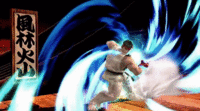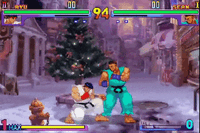Shin Shoryuken / Shinku Hadoken: Difference between revisions
Pootissnake (talk | contribs) (CvS/SvC would add to that to the point that it no longer becomes an interesting piece of trivia) |
Chippy2000 (talk | contribs) (→Trivia) |
||
| Line 48: | Line 48: | ||
*Despite being named after both moves and describing them as well, Ryu's Final Smash Trophy only depicts Shin Shoryuken. | *Despite being named after both moves and describing them as well, Ryu's Final Smash Trophy only depicts Shin Shoryuken. | ||
*The Shinku Hadoken having a vacuum effect (something it has never displayed in other appearances) may be a joke on its translated name - "''Vacuum'' Surge Fist." | *The Shinku Hadoken having a vacuum effect (something it has never displayed in other appearances) may be a joke on its translated name - "''Vacuum'' Surge Fist." | ||
*If a character somehow escaped the Shin Shoryuken in the first version Ryu was released, the game would crash. This was rectified in later versions. | |||
Revision as of 07:46, February 4, 2016
| Shin Shoryuken / Shinku Hadoken | |
|---|---|
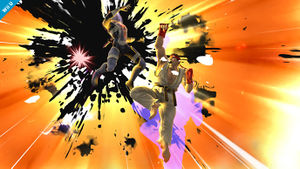 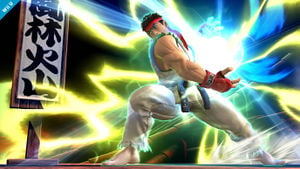 Shin Shoryuken (top) and Shinku Hadoken (bottom) in Super Smash Bros. for Wii U. | |
| User | Ryu |
| Universe | Street Fighter |
Ryu's Final Smash is unique as he can perform two versions of the attack, a first for a Final Smash. They are named Shin Shoryuken (真・昇龍拳, True Rising Dragon Fist), a three-hit trapping combo, and Shinku Hadoken (真空波動拳 , Vacuum Surge Fist), a projectile. Whichever attack he uses depends on how close he is to the opponent.
Shinku Hadoken
At any range other than point blank, Ryu will perform the Shinku Hadoken (真空波動拳 , Vacuum Surge Fist), a powerful and hard-hitting version of his standard special, Hadoken. The camera zooms in on Ryu while he gathers great amounts of blue energy (Ki) into his hands and announces "Shinku... HADOKEN!!", before he fires a large blue projectile that traps opponents that touch it. Despite the projectile's mediocre size (being only somewhat bigger than an Input Hadoken), it sucks opponents towards it with good force as it travels, making Shinku Hadoken a deceptively difficult Final Smash to escape from. Victims trapped in the projectile are repeatedly dealt small amounts of damage while it travels. Shinku Hadoken travels the distance of Final Destination before exploding, sending opponents flying with good knockback. Considering opponents get trapped the moment Ryu unleashes the projectile, it deals a maximum of 29-30% damage (19 repeated hits for 19%, final hit dealing 10% and carrying all the knockback). However, its knockback is somewhat lacking for a Final Smash, only KOing at 115%; because of this, Shinku Hadoken's use is similar to Mario Finale, which earns KOs by dragging opponents towards the blast lines, albeit being comparably smaller and weaker. However, it has very little endlag compared to most final smashes, allowing Ryu to quickly get into position to finish opponents who survived the attack. At the sides of the stage, Shinku Hadoken can KO at 75%.
Shin Shoryuken
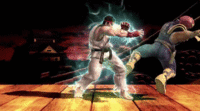
If Ryu uses his Final Smash right next to an opponent, he will instead perform the Shin Shoryuken (真・昇龍拳, True Rising Dragon Fist), a powerful 3-hit Shoryuken which has much more potent knockback while lacking the range of his Shinku Hadoken. Upon use, the camera zooms in, and Ryu stuns the opponent with a flash of blue lightning that cuts across the screen (deals 1%), before swinging his right fist for an uppercut (10%). He then performs another uppercut with his left fist, briefly pausing mid-uppercut against the opponent's chin when grunting the word "Shin..." (10%), before leaping upward and announcing "SHORYUKEN!!" (20%) as the opponent gets sent flying upwards with very high knockback. The move deals 41% damage in total, with enough knockback to KO reliably at 28%, although Ryu has to be close (sometimes even touching) the opponent for it to activate, otherwise his Final Smash becomes the Shinku Hadoken. The Final Smash can miss at this range as well, either due to intangibility, or being too far away to be trapped; if so, Ryu performs a 6-hit Shoryuken, dealing a measly 15%, before landing on the ground.
The first two punches cause white ink-like effects, while the final blow causes black ink to surround the opponent while violent action lines (similar to those in manga) focus on the Final Smash's victim. An interesting aesthetic effect of the final blow depends on whether the opponent gets enough knockback to be KO'd (a.k.a "red spark" knockback): the entire screen becomes covered in an orange background if the final blow can KO, along with a unique sound effect (this background is used in the Street Fighter series when a fighter is KO'd by a Super or Ultra Combo). The background does not appear if the last hit does not have enough force to KO the opponent (e.g. if the opponent is at 0%). The inflection in Ryu's voice also differs slightly.
Trophy Description
![[1]](https://ssb.wiki.gallery/images/thumb/1/1b/ShinShoryukenTrophyWiiU.png/200px-ShinShoryukenTrophyWiiU.png)
Use this attack when Ryu is far away from an enemy to unleash a Shinku Hadoken that penetrates through the stage. But if you use it when Ryu is close to an enemy, he’ll unleash a Shin Shoryuken uppercut attack. When it hits, Ryu will follow up with his other fist and launch the opponent up, up, and away!
Ryu's Final Smash takes on two different forms depending on how close Ryu is to the enemy. If he's farther away, he'll use Shinku Hadoken, a move that pulls in any enemies nearby. If closer, he'll instead use Shin Shoryuken. He'll hit the enemy once with a powerful uppercut, then follow it up with the other fist to finish the job!
Origin
The Shinku Hadoken first appeared in Super Street Fighter II Turbo as his trademark Super Combo (its name wasn't originally presented onscreen until Street Fighter Alpha) that later appeared in several games ever since its debut, and the Shin Shoryuken was introduced in Street Fighter III: New Generation as his second Super Art, which also appeared in several games since its debut. This move was first taught by his master Gouken. The version seen in this game combines the effects of both the first two hits of Gouken's Shin Shoryuken with the final hit effect of Ryu's Metsu Shoryuken.
The screen that shows up in the background on the final strike of Shin Shoryuken is the KO screen from Street Fighter IV, which would show up whenever the opponent lost all their health at the end of a round if attacked by a Super/Ultra Combo.
Finally, the fact that Ryu has two Final Smashes is a reference to the Ultra Combo Double mechanic introduced in Ultra Street Fighter IV where the player, instead of sticking with one Ultra Combo or the other, can use both at the cost of reduced damage on each one. In Ryu's case this would be the Metsu Hadouken and the Metsu Shoryuken. It may also be a reference to how in Street Fighter IV, some Ultra Combos would change if they missed or were blocked. Some examples are Ken's Shinryuken becoming a simple flaming uppercut if it misses or Oni's Tenchi Sokaigen being a shockwave instead of a cinematic uppercut should the opponent block it. Ryu's Shin Shoryuken in Marvel vs. Capcom 3 and his Metsu Shoryuken in Street Fighter IV also share this property, becoming simply stronger Shoryukens if they miss or are blocked. Ryu's Shin Shoryuken in Super Smash Bros. 4 retains this as well.
Trivia
- Due to the camera zooming into Ryu when Shin Shoryuken activates, the background that appears during the final blow may seem small. However, using the "Fixed" camera in Training Mode shows that the background covers the entire stage, while the "action lines" that appear around Ryu and his victim end in a circle surrounding them.
- This is the first Final Smash in the Smash Bros. series that completely changes depending on range. This hence makes Ryu the only fighter to technically have two Final Smashes in the same game.
- Additionally, as Ryu can perform his neutral special move, Hadoken, with directional inputs and both the standard and special attack button, he is the only fighter who can use his neutral special move while having a Smash Ball's glow, not counting glitches or when the Final Smash is not fully loaded.
- Shin Shoryuken uses the exact same animation that Ryu's sprite uses in Street Fighter III.
- The blue silhouettes that follow Ryu after performing his Shin Shoryuken are also a reference to super combos in the Street Fighter Alpha series.
- The black ink surrounding the opponent during the Shin Shoryuken is a Street Fighter IV aesthetic, however Ryu can not use the move in any Street Fighter IV game.
- In those games, he instead uses a more powerful version called the Metsu Shoryuken, while the Shin Shoryuken is used by another character, Gouken.
- Shin Shoryuken is one of only two Final Smashes to leave the user helpless, the other being Rocketbarrel Barrage in Brawl.
- This is somewhat faithful to the Street Fighter series, wherein a missed or blocked Super or Ultra Combo will usually leave the user open to a counterattack.
- Ryu uses the opposite hand he would use for a regular Shoryuken for Shin Shoryuken.
- However, a missed Shin Shoryuken uses the same hand as the regular Shoryuken.
- Despite being named after both moves and describing them as well, Ryu's Final Smash Trophy only depicts Shin Shoryuken.
- The Shinku Hadoken having a vacuum effect (something it has never displayed in other appearances) may be a joke on its translated name - "Vacuum Surge Fist."
- If a character somehow escaped the Shin Shoryuken in the first version Ryu was released, the game would crash. This was rectified in later versions.
